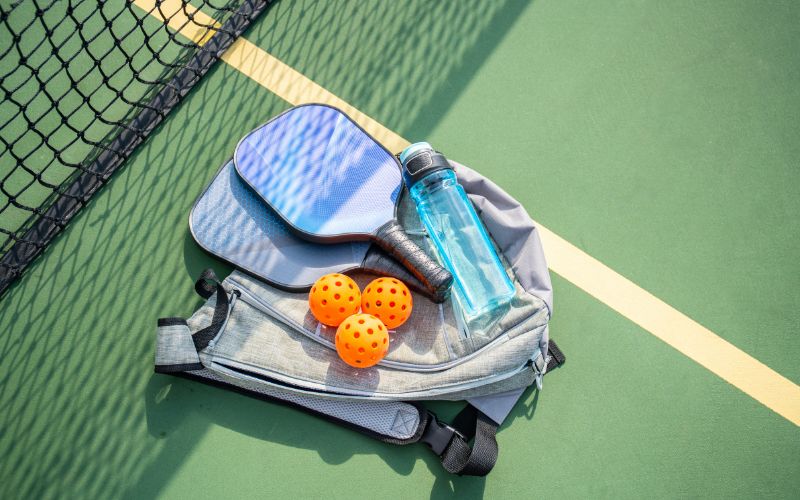Pickleball has gained immense popularity in recent years, and enthusiasts are finding creative ways to adapt existing sports facilities to accommodate this fast-paced and exciting game. One such adaptation involves playing pickleball on a tennis court. In this article, we’ll explore the step-by-step guide on how to play pickleball on a tennis court, covering everything from court setup to gameplay.
Is It Possible to Engage in a Game of Pickleball on a Tennis Court?
The straightforward response is affirmative; indeed, pickleball can be played on a tennis court. This is a significant development for pickleball enthusiasts, as it enhances the accessibility of the game.
According to the Tennis Industry Association, there are an estimated 270,000 tennis courts in the United States alone. This extensive number of courts means that there are abundant opportunities to play pickleball, and the likelihood is high that there’s a court in close proximity to you.
In some instances, tennis courts may already have dedicated pickleball lines – either permanently marked or because they are frequently used for pickleball, and players choose to leave the lines intact. In such cases, the pickleball lines are typically distinguishable by a distinct color from the tennis lines.
Alternatively, if the tennis court lacks pickleball lines, customizing the space for pickleball is a straightforward task. Fortunately, the process is uncomplicated, making it accessible for anyone eager to enjoy a game of pickleball on a tennis court.
Setting Up the Tennis Court for Pickleball
Tennis Court Dimensions and Pickleball Lines
To start playing pickleball on a tennis court, understanding the court dimensions is crucial. Tennis courts typically measure 78 feet in length and 36 feet in width. However, for pickleball, the court can be modified to fit the game’s requirements. The pickleball court dimensions are 44 feet in length and 20 feet in width, which means you can fit four pickleball courts onto a standard tennis court.
Marking Pickleball Court Lines
The first step in transforming a tennis court into a pickleball haven is marking the pickleball court lines. Use a measuring tape to ensure accuracy. Mark pickleball court lines that are 20 feet from the baseline to the non-volley zone line and 44 feet in length. These lines will help define the boundaries of each pickleball court on the tennis surface.
Utilizing Tennis Court Lines
To optimize space, make use of existing tennis court lines. The centerline of the tennis court can act as the center line for two pickleball courts. This not only minimizes line confusion but also allows for the efficient use of the tennis court.
Equipment Setup
Nets and Net Height
The pickleball net is set at a height of 34 inches at the center and 36 inches at the sidelines. If you are using a tennis net, make sure it is adjusted to the correct height. Additionally, if you have access to a pickleball net, it is recommended for a more authentic playing experience. Temporary nets are available for those who wish to convert their tennis court for occasional pickleball play.
Pickleball Paddles and Balls
Pickleball paddles are essential for the game, and each player should have one. The pickleball paddle is a solid paddle with no strings and has a shorter handle compared to a tennis racket. The game is played with a pickleball, which is similar to a wiffle ball but with distinct hole patterns. These equipment adjustments contribute to the unique playing style of pickleball.
How to Designate Pickleball Boundaries on a Tennis Court:
- Position the net at the center of one side of the tennis court. Begin by measuring the first sideline:
- Commence your measuring tape a foot inside the net and then delineate a 22-foot line extending outward from the net.
- Next, measure the baseline: Starting from the 22-foot mark on the sideline, measure and mark a horizontal distance of 20 feet for the baseline. Take note of the midpoint at 10 feet, as it will be essential later in the process.
- Proceed to measure the second sideline: Once again, initiate a measurement a foot inside the net from the opposite side post.
- Establish a straight line extending to the end of the baseline. Define the non-volley zone (The “kitchen”): Measure 7 feet from the net on each sideline and mark these points. Connect these two marked points across the court, also marking the midpoint at 10 feet.
- Connect the two 10-foot midpoint markers (ensuring one is halfway along the baseline and the other halfway across the kitchen line). Apply tape along the designated lines.
- Extend the tape from the starting point to the endpoint, gently pressing it down to ensure a straight and even application.
Playing Pickleball on a Tennis Court
Court Setup for Different Games
Whether you’re playing singles or doubles, the setup on a converted tennis court remains the same. For a singles game, use one side of the tennis court as a single pickleball court. For doubles, the center line of the tennis court acts as the dividing line between two pickleball courts.
The Non-Volley Zone and Line Confusion
Understanding the non-volley zone is crucial in playing pickleball. This zone extends 7 feet from the net on either side. Players cannot volley the ball while standing in this area. Clear markings of the non-volley zone line help in minimizing line confusion during the game.
Service Line and Kitchen Line
The service line in pickleball is situated 15 feet from the net. It is crucial for serving the ball into the opponent’s court. The kitchen line, also known as the non-volley zone line, is where players cannot volley the ball. Both lines play a significant role in defining the court’s dynamics.
Tips for Smooth Gameplay
Minimizing Line Confusion
To minimize line confusion, it’s advisable to use temporary lines if your tennis court markings are not clear. Temporary lines can be easily placed using chalk or tape, ensuring players can clearly see and adhere to the boundaries of the pickleball court.
Adapting Tennis Courts for Pickleball Community
Converting tennis courts into pickleball courts not only benefits individuals but also fosters a sense of community among pickleball enthusiasts. Consider organizing events, leagues, or social gatherings to bring the pickleball community together on your transformed tennis court.
Conclusion
Playing pickleball on a tennis court is a fantastic way to make the most of existing sports facilities. By understanding the necessary adjustments and following the guidelines provided, you can seamlessly transition from playing tennis to enjoying the exhilarating game of pickleball. So, grab your pickleball paddles, invite friends, and make your local tennis court a hub for pickleball excitement!






